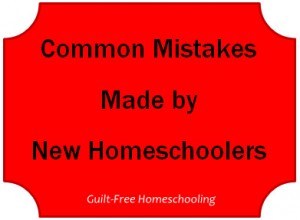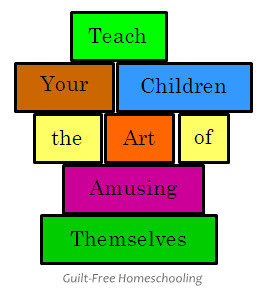The following list contains some of the more common mistakes that are often made by families new to homeschooling. These items are in random order and are by no means all of the mistakes that could be made, nor is the existence of this list a guarantee that all new homeschoolers will make these mistakes. In an effort to help families avoid these errors, I have included links to other articles containing further help, encouragement, or explanations.
1. Doubting their ability to teach their own children
2. A. Attempting to copy the schedule, curriculum, or lifestyle of another homeschooling family
B. Attempting to copy public school classroom models for time schedules, room arrangements, or teaching methods
3. Being overly strict with schoolwork, teaching methods, and discipline, thinking that is how to avoid homeschooling failure
4. A. Leaving the house too often, due to over-involvement
B. Not leaving the house enough, due to fear or due to a too-intensive load of schoolwork
5. Trying to do too much — too many subjects, too many activities, or too many projects
6. Viewing the household chores as Mom’s Work, instead of as a team activity that benefits everyone
7. Assuming that what they may have heard about homeschooling is true, without checking into the facts: legal accountability requirements, time or financial commitment, or curriculum availability
8. Giving too much information on official documents
9. Refusing to try alternate methods or materials, even when something is not working well, feeling that changing methods will bring inconsistency
10. Giving up too quickly, instead of allowing themselves time to adapt to this totally new lifestyle (the second year is much easier than Year #1)
Once again, beginning to homeschool your children does not mean that you will make any or all of the above mistakes, especially if you attempt to tailor the academics to your children’s interests and fit the educational experiences into your family’s lifestyle (instead of the other way around). Guilt-Free Homeschooling is based in the homeschooling method which is comfortable for you and keeps you relaxed (not tense and stressful). Guilt-Free Homeschooling fits your family’s lifestyle — and there can be few mistakes in that.
For more encouragement, browse through the Titles Index for intriguing articles, or check out the category listings in the Topical Index for help with a specific problem you may be enduring.





 Guilt-Free Homeschooling is the creation of Carolyn Morrison and her daughter, Jennifer Leonhard. After serious disappointments with public school, Carolyn spent the next 11 years homeschooling her two children, from elementary to high school graduation and college admission. Refusing to force new homeschooling families to re-invent the wheel, Carolyn and Jennifer now share their encouragement, support, tips, and tricks, filling their blog with "all the answers we were looking for as a new-to-homeschooling family" and making this website a valuable resource for parents, not just a daily journal. Guilt-Free Homeschooling -- Equipping Parents for Homeschooling Success!
Guilt-Free Homeschooling is the creation of Carolyn Morrison and her daughter, Jennifer Leonhard. After serious disappointments with public school, Carolyn spent the next 11 years homeschooling her two children, from elementary to high school graduation and college admission. Refusing to force new homeschooling families to re-invent the wheel, Carolyn and Jennifer now share their encouragement, support, tips, and tricks, filling their blog with "all the answers we were looking for as a new-to-homeschooling family" and making this website a valuable resource for parents, not just a daily journal. Guilt-Free Homeschooling -- Equipping Parents for Homeschooling Success!

Recent Comments